|
Gathering Around the
Parlor Stove
by Bob Brooke
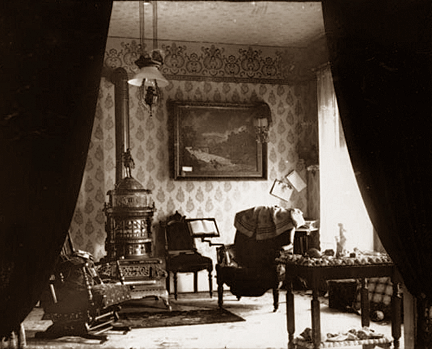 The
parlor stove not only brought warmth to the Victorian parlor but
also to country stores, shops, churches, schools and other public
buildings. Social life for Victorians often centered around these
iron monstrosities before the modern age of televisions, smartphones,
and laptop computers. Like the wireless radio that came after them,
parlor stoves provided families with a warm place to gather, tell
stories, and socialize. The
parlor stove not only brought warmth to the Victorian parlor but
also to country stores, shops, churches, schools and other public
buildings. Social life for Victorians often centered around these
iron monstrosities before the modern age of televisions, smartphones,
and laptop computers. Like the wireless radio that came after them,
parlor stoves provided families with a warm place to gather, tell
stories, and socialize.
It all started with Ben Franklin. He envisioned an improvement on
heating devices first brought to America by the Swedes, Norwegians,
and the Dutch. The Dutch "jamb" stove was nothing more than a box
full of hot coals projecting from the rear of the fireplace in-to
the room behind. Five iron plates made up the sides, top, bottom and
one end, with the other open to receive the coals shoveled in from
the fireplace. A more truly stove-like self-contained heating unit
made up of six plates was also introduced, and by 1730 a thriving
industry had grown up in Pennsylvania casting highly decorative iron
plates for both types.
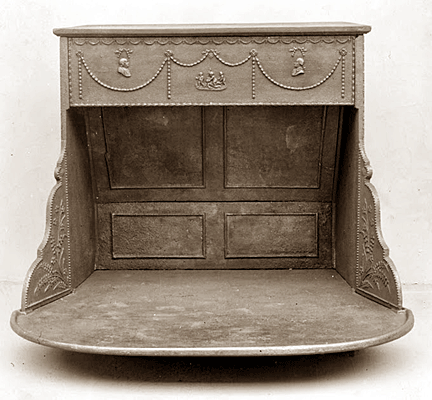 But
Franklin wanted more. Though an improvement over the fireplace,
these early stoves left Franklin cold. He disliked their
inefficiency and deplored the fact that they allowed no view of the
fire. In 1742, therefore, he presented to the world his version of
"an open stove for the better warming of rooms" It saved fuel,
circulated heat and provided visible flames to warm the soul as well
as the body. By 1774, he had perfected what he called an “iron
fireplace” which could be moved from room to room and required only
a pipe connecting it to the main fireplace flue for ventilation. It
kept a small room twice as warm using a quarter of the wood. But
Franklin wanted more. Though an improvement over the fireplace,
these early stoves left Franklin cold. He disliked their
inefficiency and deplored the fact that they allowed no view of the
fire. In 1742, therefore, he presented to the world his version of
"an open stove for the better warming of rooms" It saved fuel,
circulated heat and provided visible flames to warm the soul as well
as the body. By 1774, he had perfected what he called an “iron
fireplace” which could be moved from room to room and required only
a pipe connecting it to the main fireplace flue for ventilation. It
kept a small room twice as warm using a quarter of the wood.
Franklin gave the rights to his stove to a friend, but a London
iron-monger stole his design and named it the “Pennsylvania Stove,”
becoming rich as a result. But Franklin continued to tinker and came
up with a design for a stove that burned bituminous coal. A man
named Rumford , who eventually produced cooking stoves lined with
firebrick and soapstone between 1785 and 1795, liked the idea and
began making it. But people were slow to buy them.
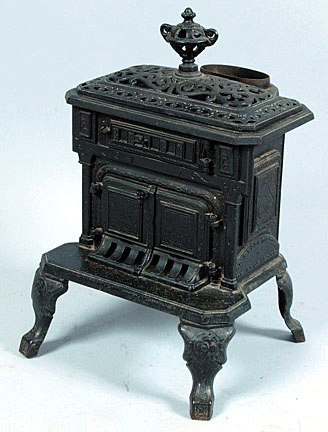 Most
people turned up their noses at these stoves. They were suspicious
of the fumes they might give off, and fastidious housewives despised
the ugly and awkward pipes that ran through rooms to reach the
fireplace chimney. Plus they worried about how quickly the stoves
got red hot. So for a time, these stoves found homes mostly in
public places—courtrooms, shops, school rooms, etc. Women wanted to
be unchained from the big fireplaces that served as heat sources for
both warmth and cooking. Most
people turned up their noses at these stoves. They were suspicious
of the fumes they might give off, and fastidious housewives despised
the ugly and awkward pipes that ran through rooms to reach the
fireplace chimney. Plus they worried about how quickly the stoves
got red hot. So for a time, these stoves found homes mostly in
public places—courtrooms, shops, school rooms, etc. Women wanted to
be unchained from the big fireplaces that served as heat sources for
both warmth and cooking.
But that didn’t stop the stove makers. They thrust upon the public
all sorts of heating variations with glowing descriptions and high
claims. Makers set up displays and demonstrations at county and
state fairs. And manufacturers were constantly reminded of an
important lesson from the past—an item for the home should look like
it belongs there. While early stoves had appealed to the spirit of
the time with Biblical scenes and slogans of liberty and equality,
makers in the early 19th century produced Victorian stoves that
blended with people’s parlor furniture.
Victorian Americans fell in love with the parlor stove and no other
country produced such a wide variety of designs. The results provid
an overview of American decorative and architectural history with an
occasional absurdity thrown in for variety. The Wilson Foolscap
Franklin Stove of 1816, for example, was fairly self-descriptive
with its big steeple top resembling a dunce cap.
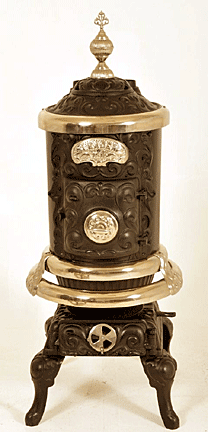 The
classical Greek urn in sizes from small to overpowering was always a
favorite stove finial. The 1840 Twin Oaks, however, was topped not
only by a huge iron urn, but by two iron trees that arched over it
with touching branches. J.B. Clute's stove of 1846 was itself a huge
iron urn on a boxlike base, modeled on one of Franklin's designs.
Moving in a different direction J.S. & M. Peckham made a beautifully
artistic shield-shaped model about 1845 that was ornamented over
every inch of its surface with naturalistic embellishments of roses,
morning glories and leaves around two children holding a logo
medallion suspended from a chain. Naturalism and classicism competed
with patriotism on the side-fueled two column stoves of Low and
Leake. One particularly eclectic model featured S-shaped columns,
allover surface decoration and an oversized spread-winged eagle on
top. The
classical Greek urn in sizes from small to overpowering was always a
favorite stove finial. The 1840 Twin Oaks, however, was topped not
only by a huge iron urn, but by two iron trees that arched over it
with touching branches. J.B. Clute's stove of 1846 was itself a huge
iron urn on a boxlike base, modeled on one of Franklin's designs.
Moving in a different direction J.S. & M. Peckham made a beautifully
artistic shield-shaped model about 1845 that was ornamented over
every inch of its surface with naturalistic embellishments of roses,
morning glories and leaves around two children holding a logo
medallion suspended from a chain. Naturalism and classicism competed
with patriotism on the side-fueled two column stoves of Low and
Leake. One particularly eclectic model featured S-shaped columns,
allover surface decoration and an oversized spread-winged eagle on
top.
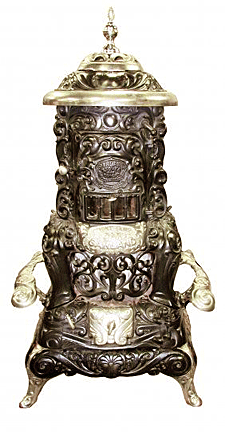 Vose
and Company made a stove in the shape of an over-trimmed Gothic
cottage, which definitely contributed to the gingerbreading of
America in the second half of the 19th century. The kitchen must
have been the target for the 1840 "folding top mahogany cabinet
stove" that looked like a dry sink when not in use, but the ultimate
in stoves made to resemble furniture must have been the bombe'-style
"dresser" complete with a mirror supported by scrolled columns. The
late Victorian parlor stove was a miracle of shining nickel-plated
ostentation, boasting mica and isinglass windows and sometimes even
set-in panels of glass or art pottery tiles for a final touch of
grace and elegance. Vose
and Company made a stove in the shape of an over-trimmed Gothic
cottage, which definitely contributed to the gingerbreading of
America in the second half of the 19th century. The kitchen must
have been the target for the 1840 "folding top mahogany cabinet
stove" that looked like a dry sink when not in use, but the ultimate
in stoves made to resemble furniture must have been the bombe'-style
"dresser" complete with a mirror supported by scrolled columns. The
late Victorian parlor stove was a miracle of shining nickel-plated
ostentation, boasting mica and isinglass windows and sometimes even
set-in panels of glass or art pottery tiles for a final touch of
grace and elegance.
With the growing acceptance of first gas, then electric heating, the
magnificent old monstrosities of the Victorian imagination finally
fell out of favor and went the way of all anachronisms, selling to
junkmen at 60 cents per hundred pound in the early 1900s.
A splendid example of the real thing is, of course, the goal for
modern collectors, though what to call the "real thing" can be a
problem. There are at least eight recognizable types of parlor
stoves. What most people imagine is the iron and nickel extravaganza
that now sells for $500 to over $1,000 or more. Cook stoves are even
hotter, especially the colored enamel models and those with ornate
nickel trim.
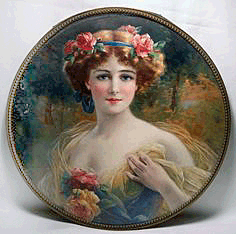 People
stored parlor stoves, no matter how ornamental, away for the summer
along with their pipes, leaving an ugly hole in the fire-place
chimney. To remedy this the flue cover was born. Attractive prints,
generally under round or oval glass and hung by chains, are what
collectors want. Common scenes market for $30 to $65, but the
unusual and desirable can bring up to $300. Manufacturers produced
some in a matched set of three—one functional and two for show. The
rarest were reverse painted on glass. People
stored parlor stoves, no matter how ornamental, away for the summer
along with their pipes, leaving an ugly hole in the fire-place
chimney. To remedy this the flue cover was born. Attractive prints,
generally under round or oval glass and hung by chains, are what
collectors want. Common scenes market for $30 to $65, but the
unusual and desirable can bring up to $300. Manufacturers produced
some in a matched set of three—one functional and two for show. The
rarest were reverse painted on glass.
Today, the center of our social system is the smartphone with
television or possibly the laptop computer a close second. Instead
of sitting together around the old parlor stove with its radiant
windows in a pleasant end-of-day indoor twilight, filling the
silence with spoken thoughts, shared ideas and stories, individuals
are drawn into the screens of their smartphones or are surrendering
to the watching endless reality shows or streaming movies in their
our own island of solitude. Wouldn't it be great if just once in a
while people would take the advice of a subscriber who wrote to
Scribner's in 1878. "Put in one of these stoves, with its glowing
fire," he urged, "and see how bright and cheery everyone around will
feel." That sure beats Facebook.
<
Back to More Antique Spotlights
Next Article > |
